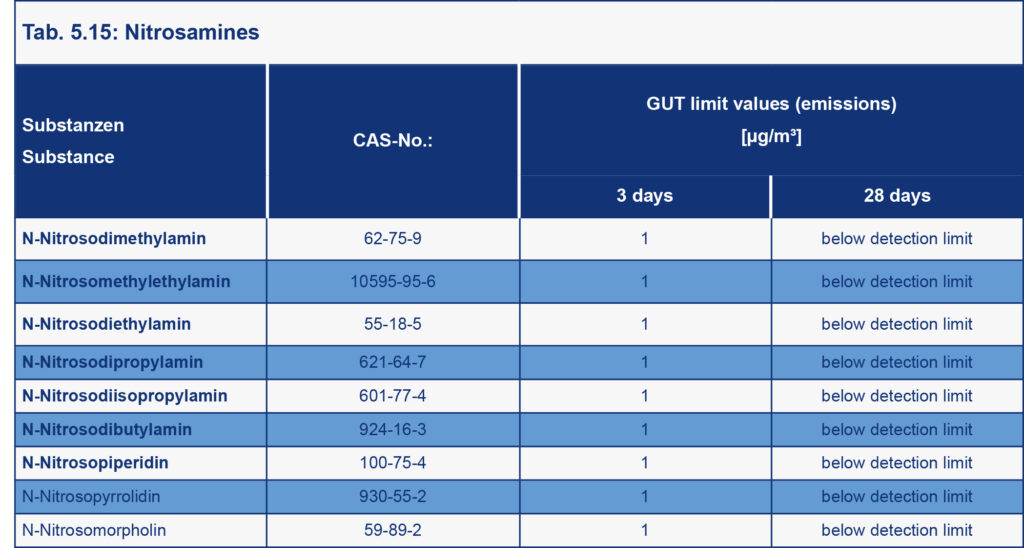Grenswaarden en gebruiksverboden
voor afzonderlijke stoffen of groepen van stoffen
bij het testen van vloerbedekkingen
Lees op deze pagina meer over de grenswaarden van en gebruiksverboden voor bepaalde stoffen en groepen van stoffen bij de productie van textiele vloerbedekkingen.
Veiligheid voor de consument & milieubescherming
Met behulp van klassieke chemische analyses in combinatie met moderne sneltests worden zowel de grondstoffen als de textiele vloerbedekking als eindproduct op veel verschillende schadelijke stoffen getest. Dit zijn onder andere zware metalen, weekmakers, biociden en pesticiden, de klassieke POP’s (Persistant Organic Pollutants) en de REACH SVHC’s.
Voor de hieronder vermelde stoffen of groepen van stoffen zijn in het GUT-systeem grenswaarden vastgelegd of gebruiksverboden gedefinieerd.
Deze maatregelen zijn niet alleen met het oog op de veiligheid van de consument genomen, maar zijn ook genomen om te voorkomen dat dit negatieve gevolgen voor het milieu heeft. In de volgende tabellen vindt u informatie over de afzonderlijke milieuklassen en de toegewezen grenswaarden.
Kleurstoffen en verfhulpstoffen (1 van 7)
MEER INFORMATIE:
Het is verboden kleurstoffen te gebruiken die in het GUT-systeem in de categorie allergenen of kankerverwekkende stoffen vallen.
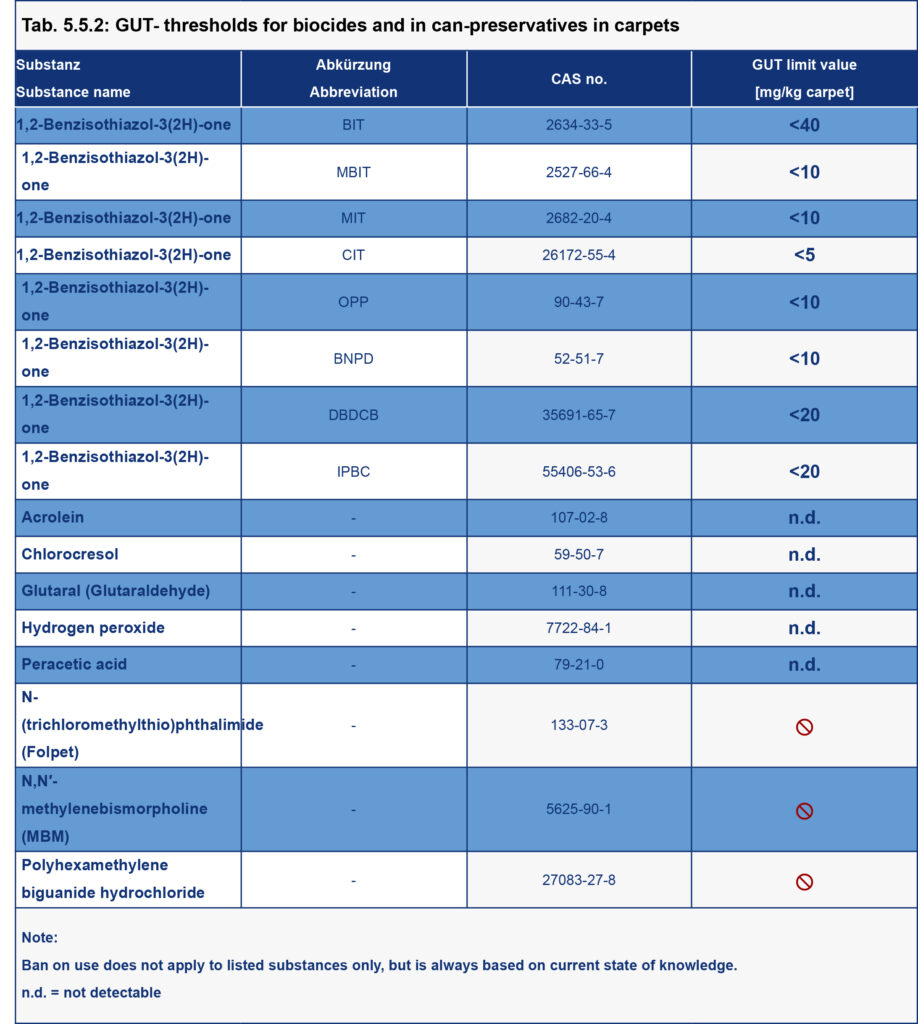
MEER INFORMATIE:
Van de circa 4.000 kleurstoffen in de colourindex zijn ongeveer de helft azokleurstoffen. Daarmee zijn ze met afstand de belangrijkste groep van kleurstoffen. Bij het produceren van deze azokleurstoffen worden vaak kankerverwekkende amines gebruikt en enkele amines zijn ook nu nog commercieel verkrijgbaar. Na opname in het lichaam kunnen deze azoverbindingen in de stofwisseling achterblijven en de aromatische amines vormen waaruit deze zijn gesynthetiseerd. Darmbacteriën maar ook bepaalde enzymen in de lever kunnen dit proces in gang zetten.
Het gebruik van de vermelde azokleurstoffen is binnen het GUT-systeem verboden.
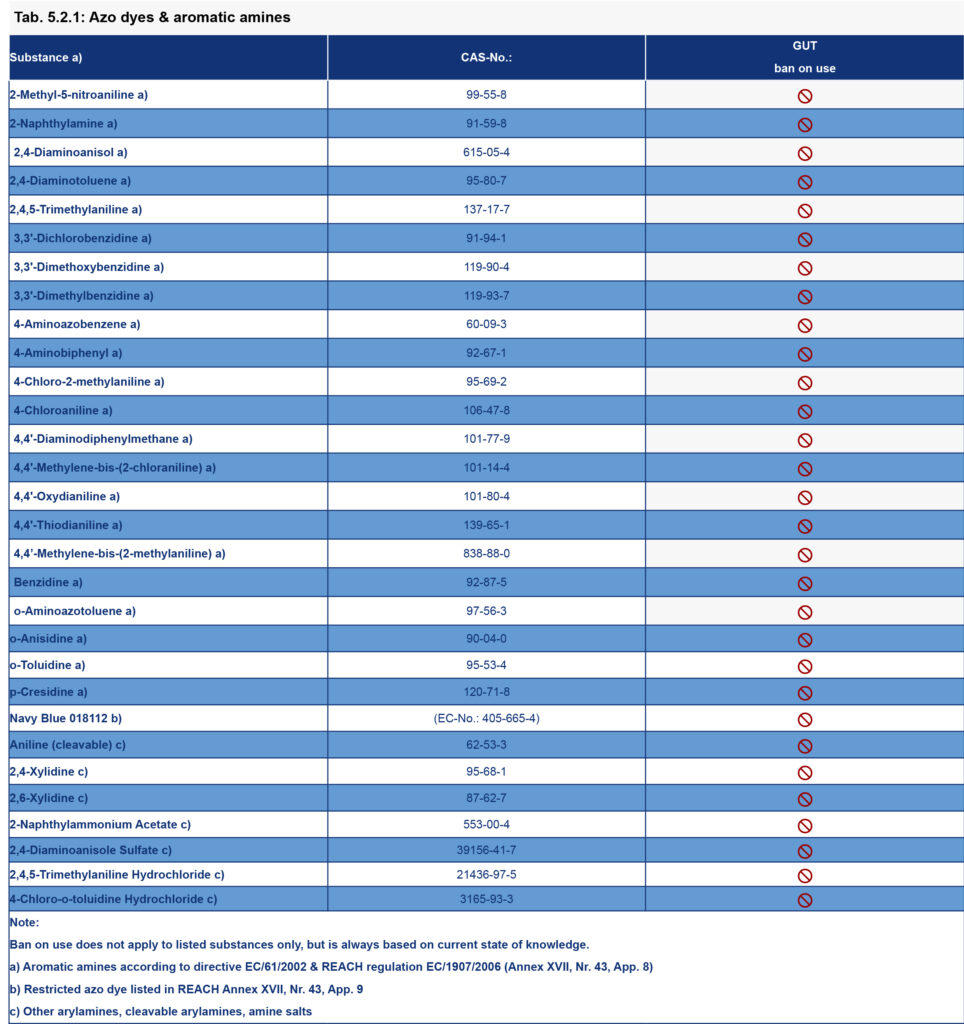
MEER INFORMATIE:
Kleuractivators (carriers) zijn organische oplosmiddelen die als hulpstoffen worden gebruikt als bij de productie van synthetische vezels (polyester, acetaat, polyacrylonitryl, polyamide) gedispergeerd kleuren wordt toegepast. Ze zorgen ervoor dat de kleurstoffen sneller in de vezels doordringen. Het kleuren met gedispergeerde kleurstoffen is vooral heel belangrijk voor polyester (polyethyleentereftalaat, PET) als de met afstand belangrijkste synthetische vezel voor kleding. Het gedispergeerd kleuren wordt in dit geval met behulp van carriers op 95 °C of in omstandigheden met hoge temperaturen (HT) op 130 °C uitgevoerd. Voor het HT-kleuren zijn in principe geen carriers nodig, maar ze worden ook daar in lagere hoeveelheden als egalisatiecarriers gebruikt om een egale kleur te krijgen. Ook voor het kleuren van mengsels van wol en polyester worden carriers gebruikt omdat de temperatuur door het wolgehalte moet worden beperkt tot 110 tot 115 °C.
Na het verven bedraagt het restgehalte afhankelijk van de stof en de kleurmethode aanvankelijk 5 tot 37 g/kg vezel (0,5 tot 3,7%). Dit gehalte kan met verschillende nabehandelingen worden verlaagd, maar het is vrijwel onmogelijk om de carriers volledig te verwijderen. Als het kleuren volgens de stand van de techniek is uitgevoerd, bedraagt de concentratie dragers minder dan 0,2%, anders kan de concentratie op het textiel oplopen tot wel 2,7%.
Het gebruik van de vermelde kleuractivators is binnen het GUT-systeem niet toegestaan.

Zware metalen en weekmakers (2 van 7)
MEER INFORMATIE:
Weekmakers zijn stoffen die aan breekbare materialen worden toegevoegd om ze zacht, flexibel of rekbaar te maken, zodat ze makkelijker te verwerken zijn of bepaalde gebruikseigenschappen krijgen. Ze zijn in grote hoeveelheden in kunststoffen, lakken, verf en coatingen, afdichtingsmiddelen, artikelen van rubber en in lijm te vinden.
Ook bij de textielafwerking spelen weekmakende stoffen een rol om de stroefheid en soepelheid te verbeteren. De weekmakers kunnen uit het materiaal komen.
Belangrijke bronnen van weekmakers in de binnenlucht en in huisstof zijn bouwproducten zoals vloerbedekking, leuningen, deur- en raamafdichtingen (als ze hard of zacht pvc bevatten), elektrische kabels, sommige meubels die zijn gemaakt met lijm of verf die ftalaten bevat en woonaccessoires, bad- en douchematten en douchegordijnen.
Vooral weekmakers op basis van ftalaten baren zorgen vanwege hun hormonale effecten.
Het gebruik van de hierna vermelde stoffen is binnen het GUT-systeem niet toegestaan.
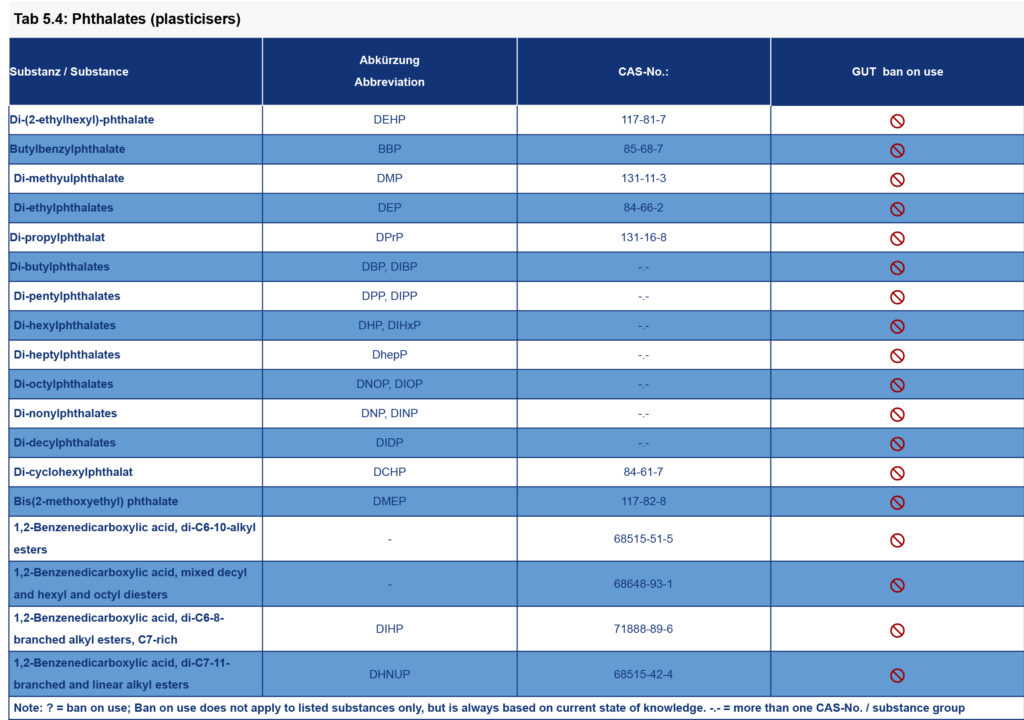
MEER INFORMATIE:
Zware metalen komen van nature in verschillende vormen voor. Ze spelen een belangrijke rol in het plantaarlijke, dierlijke en menselijke organisme. Een gebrek aan essentiële zware metalen kan zonder meer tot gezondheidsproblemen leiden.
Maar veel zware metalen, zoals lood of arseen, kunnen juist ook tot ernstige vergiftiging leiden als er te veel van in het lichaam wordt opgenomen.
Om te voorkomen dat bepaalde zware metalen in het milieu terechtkomen, zijn in het GUT-systeem verschillende grenswaarden vastgelegd. Deze hebben betrekking op het gehalte van een zwaar metaal of op het vrijkomen van een zwaar metaal onder bepaalde omstandigheden.
In de volgende tabel is een overzicht van de momenteel geldende grenswaarden te vinden.

Biociden, potconserveringsmiddelen en pesticiden (3 van 7)
MEER INFORMATIE:
In de Europese wetgeving worden biociden gedefinieerd als chemische stoffen of micro-organismen die zijn bedoeld om schadelijke organismen met chemische of biologische middelen te vernietigen, af te schrikken, onschadelijk te maken, de effecten daarvan te voorkomen of ze op een andere wijze te bestrijden.
Deze verordening heeft ten doel de werking van de markt voor biociden in de EU te verbeteren en tegelijk een hoog niveau van bescherming van de gezondheid voor de mens en het milieu veilig te stellen.
Binnen het GUT-systeem gelden de volgende principes voor het gebruik van biociden:
- Biociden moeten voor gebruik in de EU zijn toegelaten als
- productsoort 6: conserveringsmiddelen in conserven;
- productsoort 11: conserveringsmiddelen voor vloeistofkoelings- en verwerkingssystemen;
- productsoort 12: slijmbestrijdingsmiddelen
- voor deze toegelaten biociden gelden GUT-hoeveelheden en/of elutiedrempelwaarden voor het tapijt als eindproduct (zie tabel);
- het actieve gebruik of de toevoeging van biociden aan textiele vloerbedekking als appreteermiddel of oppervlaktebehandeling is verboden.
Dit is met uitzondering van de behandeling van wollen tapijt met permethrine (zie wol 5.10).
Een actieve biocide, biostatische of fungicide afwerking is dus niet toegestaan. Als de fabrikant textiele vloerbedekkingen met en zonder biociden aanbiedt, geldt de GUT-licentie alleen voor het product zonder biociden.
Opmerking:
Het gebruik van biociden, vooral bij de productie en opslag van grondstoffen, kan niet helemaal worden uitgesloten omdat de conservering van grondstoffen of het onderhoud van productie-installaties nodig is om biologische verontreiniging van het eindproduct te voorkomen. Hierbij kunnen er resten in het tapijt terechtkomen. Het doel is om het restgehalte van deze conserveringsmiddelen tot een niveau te verlagen dat voor de gebruiker geen schade veroorzaakt. Daarom worden in dit geval alleen biociden geaccepteerd die in de Verordening biociden (BPR, verordening (EU) 528/2012) zijn toegelaten en opgenomen.
Biociden waarvan bekend is of vermoed wordt dat ze kankerverwekkend, mutageen of vergiftig voor de voortplanting zijn, zijn binnen het GUT-systeem niet toegestaan, zelfs als ze voor gebruik in de EU zijn toegelaten.
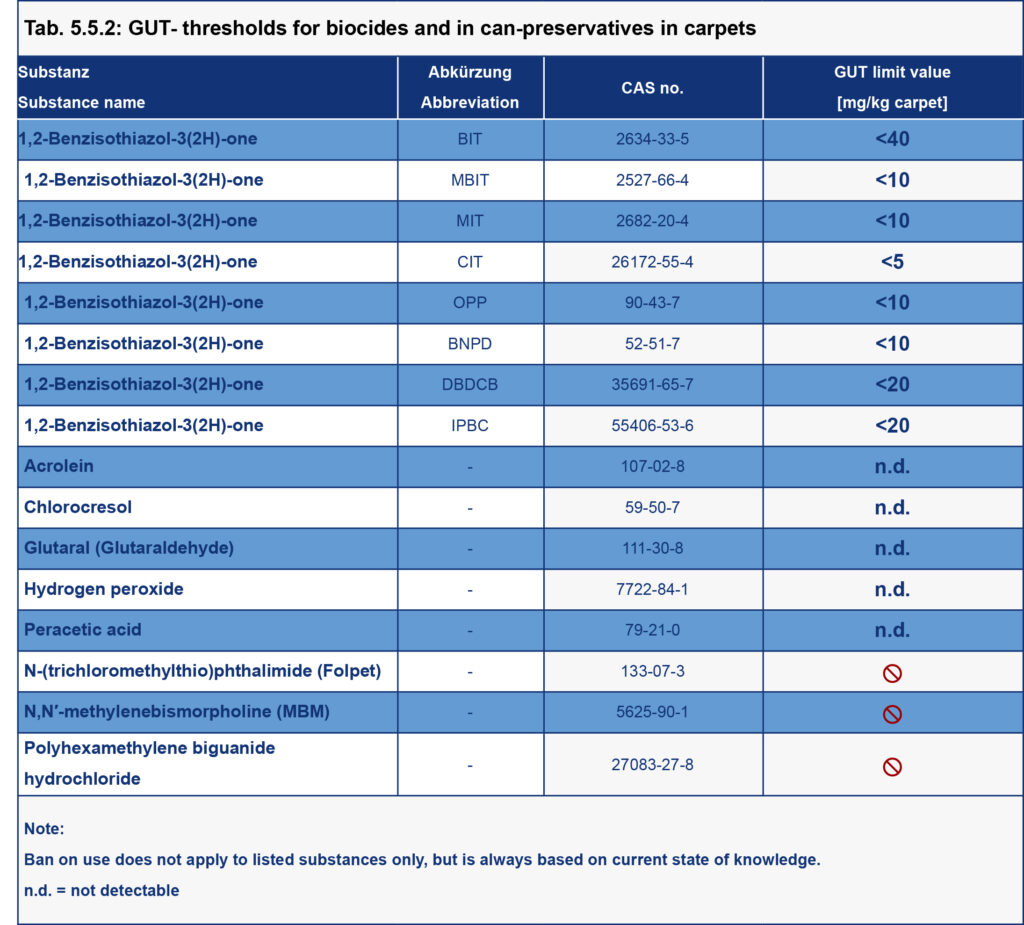
5.5.2.Grenzwerte & Verwendungsverbote_ Substanzen in Teppichböden_biozide
MEER INFORMATIE:
Chloorfenolen behoren tot de groep van gechloreerde organische bestrijdingsmiddelen. Chloorfenolen worden gebruikt als houtconserveringsmiddelen, herbiciden, fungiciden en voor het bleken van pulp bij het maken van papier. PCP is vanwege zijn giftige werking al lang verboden.
Bronnen van chloorfenolen in binnenruimtes:
- met houtconserveringsmiddel behandelde houtoppervlakken, bijvoorbeeld planken, vloeren, kozijnen, dakspanten;
- behandeld en geïmpregneerd textiel van leer, bijvoorbeeld bankstellen, schoenen, leren bekleding;
- behandelde natuurlijke materialen, bijvoorbeeld wol, kokosvezels;
- verf, lak.
Het gebruik van de hierna vermelde stoffen is binnen het GUT-systeem verboden.
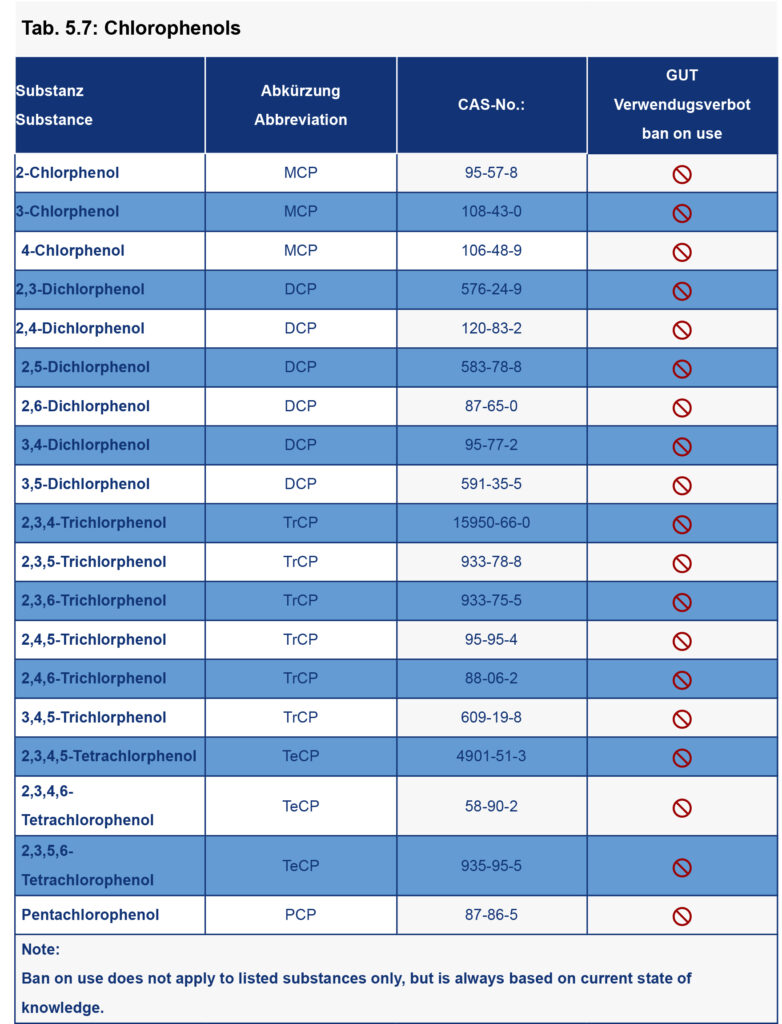
MEER INFORMATIE:
Organische tinverbindingen kunnen als biociden in houtconserveringsmiddelen, maar ook als additieven en katalysatoren worden gebruikt. Aan het einde van de jaren 90 werd op jaarbasis zo’n 40.000 ton geproduceerd.
- 76% werd gebruikt als stabilisatoren voor pvc;
- 10% werd gebruikt als biociden in onderwatercoatings;
- 8% werd gebruikt als fungiciden;
- 5% werd gebruikt als katalysatoren bij de productie van polyurethaan schuim en siliconen
Het gebruik van deze verbindingen is in de EU grotendeels verboden.
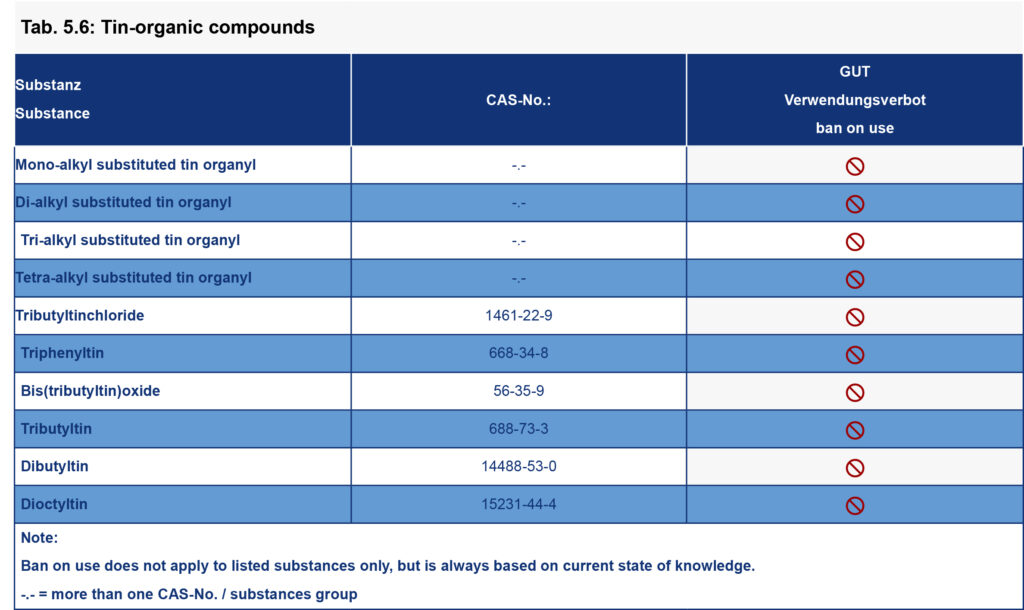
MEER INFORMATIE:
Tegenwoordig worden alle gewasbeschermingsmiddelen en andere middelen voor plagenbestrijding als pesticiden bestempeld. De EU-richtlijn 2009/128/EG bevat een definitie voor ‘pesticide’. Volgens deze definitie vallen hier zowel gewasbeschermingsmiddelen als omschreven in Verordening (EG) nr. 1107/2009 (verordening betreffende gewasbeschermingsmiddelen) als biociden als omschreven in Richtlijn 98/8/EG betreffende het op de markt brengen van biociden onder.
Als in het publieke debat over ‘pesticideresten’ wordt gesproken, gaat het er meestal om dat levensmiddelen aan resten van gewasbeschermingsmiddelen worden blootgesteld.
Het gebruik van de hierna vermelde stoffen is binnen het GUT-systeem verboden.
Formaldehyde en behandelde wol (4 van 7)
Wol is een vezel op basis van keratine en wordt daardoor door veel verschillende insecten (en larven) als voedingsbron gebruikt. Mottenlarven zijn het bekendste voorbeeld hiervan.
Daarom worden veel verschillende chemicaliën gebruikt om de wolvezels te beschermen.
Maar binnen het GUT-systeem is de enige werkzame stof die voor het beschermen van wolvezels is toegestaan, permethrine.
Er zijn in totaal 3 veiligheidsklassen die afhankelijk van de aangebrachte hoeveelheid en daarmee het veiligheidsniveau verschillen. Het maximaal toegestane gehalte aan permethrine bedraagt 210 mg per 1 kg wol:
- Klasse 1: geen bescherming := de wolvezels zijn niet met permethrine behandeld;
- Klasse 2: normale bescherming := de wolvezels zijn met maximaal 150 mg permethrine per 1 kilo wolvezels behandeld.
Klasse 3: hoge bescherming := de wolvezels zijn met maximaal 210 mg permethrine per 1 kilo wolvezels behandeld.
Om de wol te behandelen, mogen alleen methoden worden gebruikt waarvan kan worden gegarandeerd dat de vezels langdurig zijn beschermd. Spraytoepassingen zijn niet toegestaan.
MEER INFORMATIE:
Er zijn veel producten die formaldehyde bevatten en die formaldehyde in de binnenlucht uitstoten. Hoewel de producten de afgelopen decennia zijn verbeterd, gelden houten materialen, vloerbedekking, meubels en bepaalde isolatiematerialen (bijvoorbeeld ureum-formaldehyde-purschuim) nog steeds als hoofdbronnen. In tabaksrook zit ook nog relatief veel formaldehyde en zelfs brandende kaarsen kunnen een bron van formaldehyde in de binnenlucht zijn. Formaldehyde is verder ook te vinden in sommige ontsmettingsmiddelen, cosmetica-artikelen en in textiel.
Het gebruik van formaldehyde en chemicaliën die formaldehyde uitstoten, is binnen het GUT-systeem verboden.
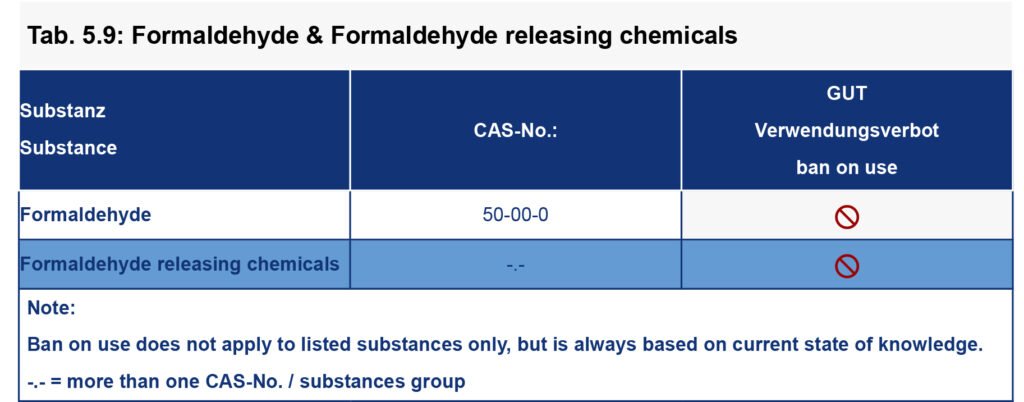
Brandvertragers en PAK’s (5 van 7)
MEER INFORMATIE:
Bij brandvertragers gaat het om veel verschillende organische en organische chemicaliën. Het gebruik van deze brandvertragers wordt steeds afgestemd op het specifieke product, de materiaalsamenstelling en het gebruiksdoel. Producten waar brandvertragers in zitten, zijn bijvoorbeeld de behuizing van elektrische en elektronische apparaten, printplaten, kabels, coatingen op de achterkant van tapijt, speciaal textiel, isolatiemateriaal en montageschuim. De organische brandvertragers bestaan vooral uit broomhoudende verbindingen, gehalogeneerde of halogeenvrije fosforverbindingen of chloorparaffinen.
Als anorganische brandvertragers worden voornamelijk aluminiumtrihydroxide (ATH), magnesiumdihydroxide of antrimontioxide (als synergistisch middel van broomhoudende brandvertragers) gebruikt.
Binnen het GUT-systeem zijn de vermelde chemicaliën niet toegelaten.
Voor 73% van het tapijt voor privégebruik hoeft er geen extra brandvertrager te worden gebruikt om aan de verklaarde brandveiligheidsklasse te voldoen. In alle andere gevallen wordt ATH gebruikt.
In openbare gebouwen, waar deels hogere veiligheidsvoorschriften gelden, is zo’n 54% van het tapijt met brandvertragers uitgerust.
MEER INFORMATIE:
Procesoliën met een PAK-gehalte zijn goedkoop en worden in veel verschillende consumptiegoederen gebruikt. Verder wordt carbon black vaak ook gebruikt om kunststoffen en rubber zwart mee te kleuren.
Veel PAK’s hebben eigenschappen die kankerverwekkend, mutageen of vergiftig voor de voortplanting zijn. Een aantal PAK’s zijn tegelijkertijd persistent, bioaccumulerend en giftig (toxisch) voor mensen en andere organismen.
PAK’s ontstaan door onvolledige verbranding van organisch materiaal zoals hout, kolen of olie. Over het algemeen geldt: hoe lager de temperatuur van het vuur is en hoe minder zuurstof aanwezig is, des te onvollediger de materialen verbranden en des te meer PAK’s ontstaan. Maar een groot deel van de PAK’s komt al in de atmosfeer door natuurlijke processen, zoals bosbranden of vulkaanuitbarstingen, waar de mens geen invloed op heeft.
Ook door de mens veroorzaakte PAK-emissies ontstaan voornamelijk bij verbrandingsprocessen, bijvoorbeeld bij kleine stookinstallaties, industriële processen, open haarden of tabaksrook.
Voor textiele vloeren gelden binnen het GUT-systeem de volgende grenswaarden.
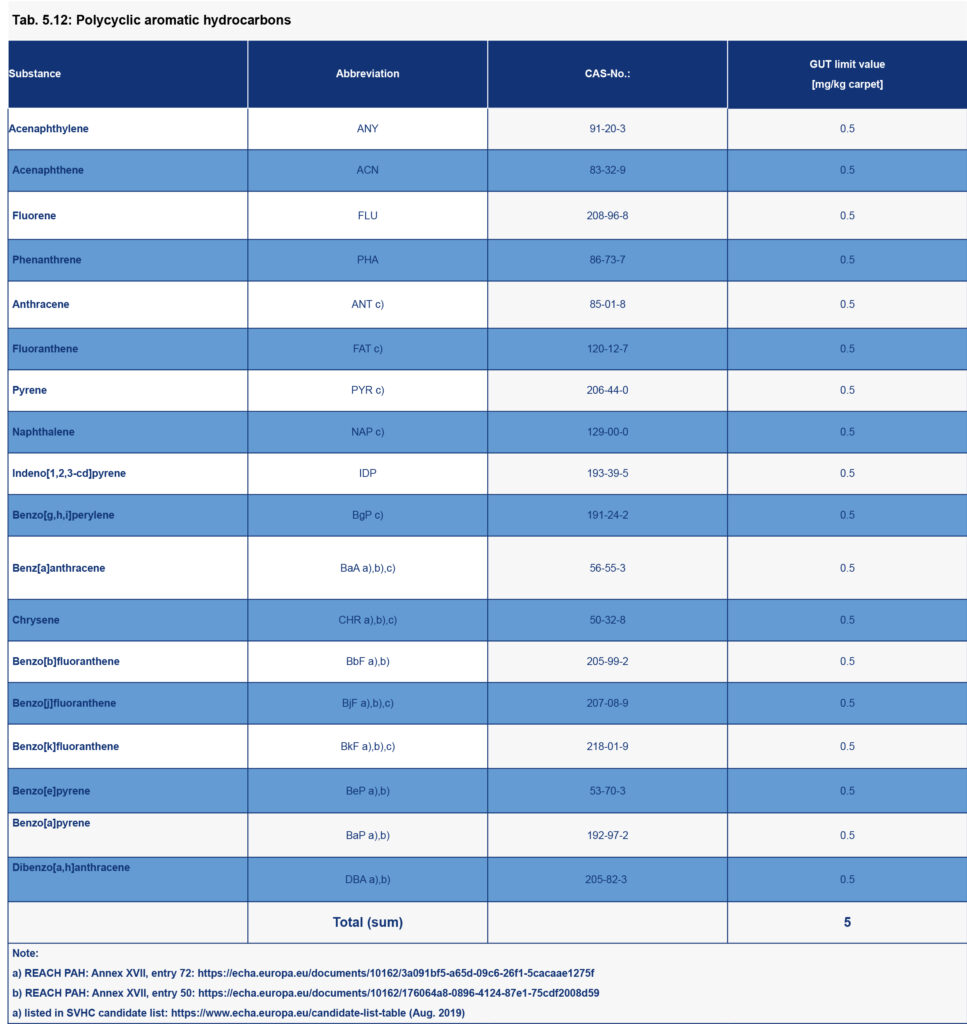
Geperfluoreerde stoffen (6 van 7)
MEER INFORMATIE:
Wat al deze stoffen gemeen hebben, is dat de koolstof-waterstof-binding die kenmerkend is voor organische verbindingen, volledig of minstens deels door een koolstof-fluor-binding is vervangen. Deze binding is extreem stabiel en geeft de stoffen een hoge chemische en thermische bestendigheid.
Perfluoroctaansulfonzuur (PFOS) en perfluoroctaanzuur (PFOA) zijn beide industriële chemicaliën. PFOS werd tot 2006 bijvoorbeeld als basis gebruikt om vuil-, vet- en waterafstotende oppervlaktebehandelingen van tapijten, bekleding en verpakkingen van papier en karton te maken. Verder werd dit zuur ook in brandblussers gebruikt.
Maar sinds 2006 is het gebruik van PFOS in de EU aan banden gelegd en is het zuur alleen nog toegelaten voor enkele speciale toepassingen. Verbindingen op basis van PFOA mogen daarentegen nog tot 2020 worden gebruikt. Ze worden in de industrie gebruikt om anti-aanbaklagen voor braadpannen te maken en om kleding water-, olie- en vuilafstotend te maken.
Maar vanaf 2020 mogen PFOA’s en daarvan afgeleide zouten en precursoren niet meer worden geproduceerd of op de markt worden gebracht. Beide stoffen zijn chemisch heel stabiel, lossen op in zowel water als vet en komen daardoor makkelijk in het milieu terecht. Van daaruit komen ze de voedselketen in.
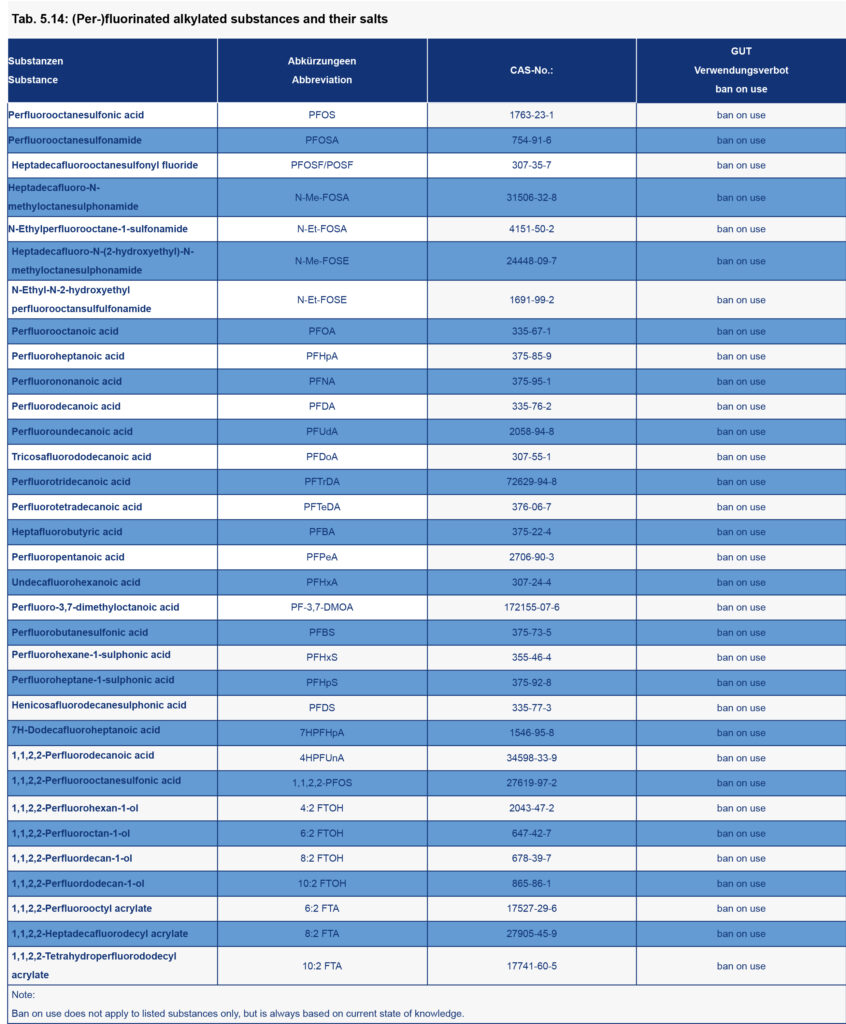
Anorganische vezels, nitrosaminen en andere stoffen (7 van 7)
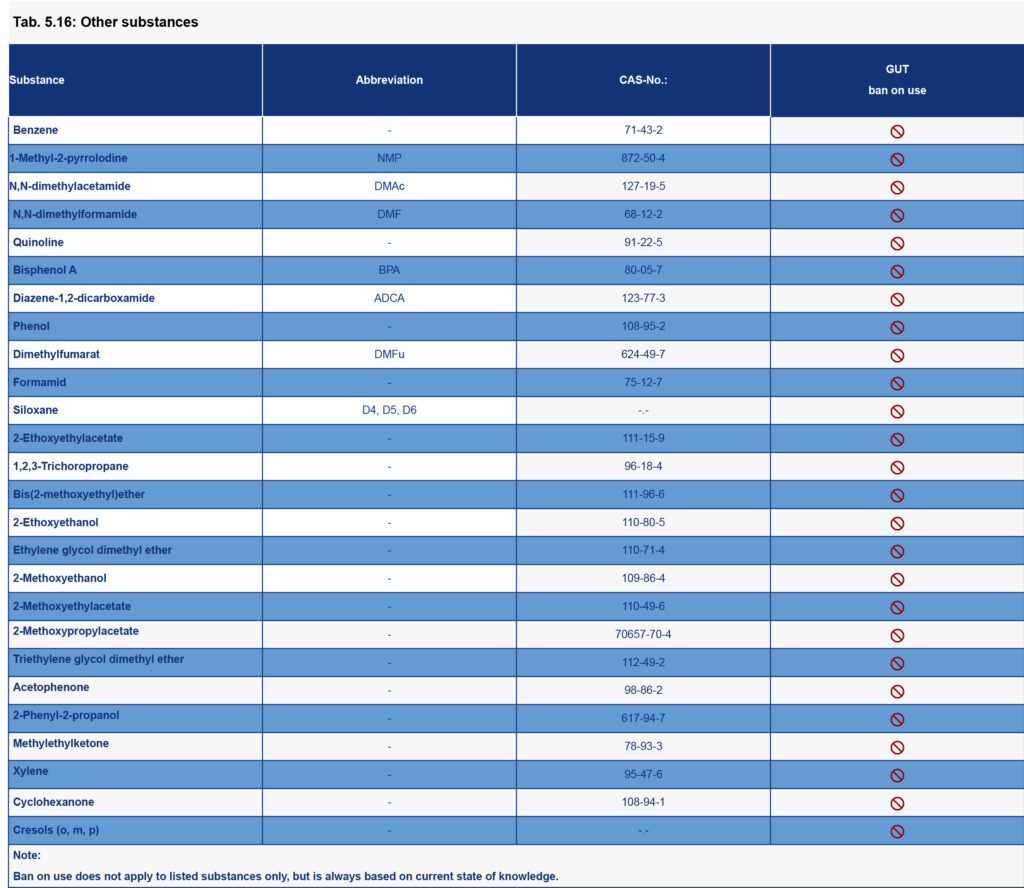
MEER INFORMATIE:
Asbest is een verzamelnaam voor verschillende in de natuur voorkomende, vezelachtige en gekristalliseerde silicaatmineralen (anorganische vezels) die na bewerking technisch bruikbare vezels in verschillende lengtes vormen.
Deze vezels breken makkelijk, waarna de deeltjes makkelijk zijn in te ademen vanwege de verhouding van lengte tot diameter. In dat geval kunnen de ingeademde vezels longkanker veroorzaken.Het gebruik van asbestvezels is binnen het GUT-systeem verboden.
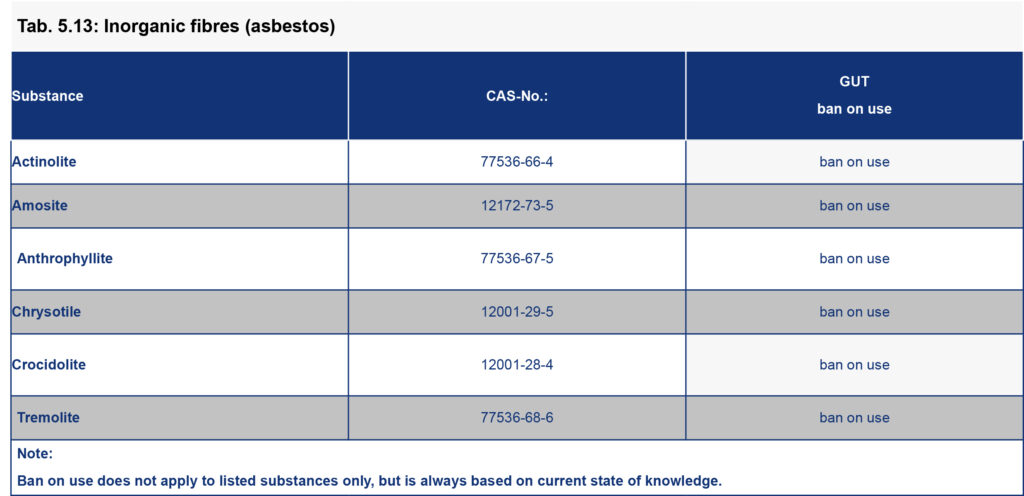
MEER INFORMATIE:
Bij het produceren van gevulkaniseerd schuim op SBR-basis worden zogenaamde vulcanisatieversnellers gebruikt. Deze stoffen kunnen onder bepaalde omstandigheden nitrosaminen vormen.
Binnen het GUT-systeem is het gebruik van zink-diethyldithiocarbamaat als vulcanisatieversneller verboden.
Voor nitrosaminen gelden de volgende emissiegrenswaarden.
